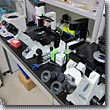PUBLICATIONS
The following is a list of some recent publications from the lab, along with the abstract and download links. A complete list of Enomoto's publications can be found here.
|
A fast track to gut innervation
Nishiyama, C., Uesaka, T., Manabe, T., Yonekura, Y., Nagasawa, T., Newgreen, D. F., Young, H. M., Enomoto, H. (2012) |
Cell migration is fundamental to organogenesis. During development, the enteric neural crest cells (ENCCs) that give rise to the enteric nervous system (ENS) migrate and colonize the entire length of the gut, which undergoes substantial growth and morphological rearrangement. How ENCCs adapt to such changes during migration, however, is not fully understood. Using time-lapse imaging analyses of mouse ENCCs, we show that a population of ENCCs crosses from the midgut to the hindgut via the mesentery during a developmental time period in which these gut regions are transiently juxtaposed, and that such 'trans-mesenteric' ENCCs constitute a large part of the hindgut ENS. This migratory process requires GDNF signaling, and evidence suggests that impaired trans-mesenteric migration of ENCCs may underlie the pathogenesis of Hirschsprung disease (intestinal aganglionosis). The discovery of this trans-mesenteric ENCC population provides a basis for improving our understanding of ENS development and pathogenesis.
|
|
Mutations in Phox2b tied to common neural crest disorders
Nagashimada, M., Ohta, H., Li, C., Nakao, K., Uesaka, T., Brunet, J. F., Amiel, J., Trochet, D., Wakayama, T., Enomoto, H. (2012) |
The most common forms of neurocristopathy in the autonomic nervous system are Hirschsprung disease (HSCR), resulting in congenital loss of enteric ganglia, and neuroblastoma (NB), childhood tumors originating from the sympathetic ganglia and adrenal medulla. The risk for these diseases dramatically increases in patients with congenital central hypoventilation syndrome (CCHS) harboring a nonpolyalanine repeat expansion mutation of the Paired-like homeobox 2b (PHOX2B) gene, but the molecular mechanism of pathogenesis remains unknown. We found that introducing nonpolyalanine repeat expansion mutation of the PHOX2B into the mouse Phox2b locus recapitulates the clinical features of the CCHS associated with HSCR and NB. In mutant embryos, enteric and sympathetic ganglion progenitors showed sustained sex-determining region Y (SRY) box10 (Sox10) expression, with impaired proliferation and biased differentiation toward the glial lineage. Nonpolyalanine repeat expansion mutation of PHOX2B reduced transactivation of wild-type PHOX2B on its known target, dopamine β-hydroxylase (DBH), in a dominant-negative fashion. Moreover, the introduced mutation converted the transcriptional effect of PHOX2B on a Sox10 enhancer from repression to transactivation. Collectively, these data reveal that nonpolyalanine repeat expansion mutation of PHOX2B is both a dominant-negative and gain-of-function mutation. Our results also demonstrate that Sox10 regulation by PHOX2B is pivotal for the development and pathogenesis of the autonomic ganglia.
|
|
Genetic Intervention in Mouse Hirschspurng Disease
Uesaka, T. and Enomoto, H. (2010) |
The RET tyrosine kinase is required for the migration, proliferation, and survival of the enteric neural crest-derived cells (ENCCs) that form the enteric nervous system (ENS). Hypomorphic RET alleles cause intestinal aganglionosis [Hirschsprung disease (HSCR)], in which delayed migration and successive nonapoptotic ENCC death are considered to be major contributory factors. The significance of ENCC death in intestinal aganglionosis, however, has remained unclear. We show that elevated expression of Bcl-xL inhibits ENCC death in both Ret-null and hypomorphic states. However, the rescued Ret-null mice showed ENS malfunction with reduced nitric oxide synthase expression in colonic neurons, revealing the requirement of RET for neuronal differentiation. In contrast, the inhibition of cell death allows morphologically and functionally normal ENS formation in Ret hypomorphic mice. These results indicate that ENCC death is a principal cause of intestinal aganglionosis in a Ret hypomorphic state, and suggest that the inhibition of cell death is a route to the prevention of HSCR.
|
|
Improved model yields new insights into Hirschsprung's disease
Uesaka, T., Nagashimada, M., Yonomura, S., and Enomoto, H. (2008) |
Mutations in the RET gene are the primary cause of Hirschsprung disease (HSCR), or congenital intestinal aganglionosis. However, how RET malfunction leads to HSCR is not known. It has recently been shown that glial cell line-derived neurotrophic factor (GDNF) family receptor alpha1 (GFRalpha1), which binds to GDNF and activates RET, is essential for the survival of enteric neurons. In this study, we investigated Ret regulation of enteric neuron survival and its potential involvement in HSCR. Conditional ablation of Ret in postmigratory enteric neurons caused widespread neuronal death in the colon, which led to colonic aganglionosis. To further examine this finding, we generated a mouse model for HSCR by reducing Ret expression levels. These mice recapitulated the genetic and phenotypic features of HSCR and developed colonic aganglionosis due to impaired migration and successive death of enteric neural crest-derived cells. Death of enteric neurons was also induced in the colon, where reduction of Ret expression was induced after the period of enteric neural crest cell migration, indicating that diminished Ret expression directly affected the survival of colonic neurons. Thus, enteric neuron survival is sensitive to RET dosage, and cell death is potentially involved in the etiology of HSCR.
|
|
Unsuspected neuronal specificity in GDNF function
Gould, T. W., Yonemura, S., Oppenheim, R. W., Ohmori, S., and Enomoto, H. (2008) |
Glial cell line-derived neurotrophic factor (GDNF) regulates multiple aspects of spinal motoneuron (MN) development, including gene expression, target selection, survival, and synapse elimination, and mice lacking either GDNF or its receptors GDNF family receptor alpha1 (GFRalpha1) and Ret exhibit a 25% reduction of lumbar MNs at postnatal day 0 (P0). Whether this loss reflects a generic trophic role for GDNF and thus a reduction of all MN subpopulations, or a more restricted role affecting only specific MN subpopulations, such as those innervating individual muscles, remains unclear. We therefore examined MN number and innervation in mice in which Ret, GFRalpha1, or GDNF was deleted and replaced by reporter alleles. Whereas nearly all hindlimb muscles exhibited normal gross innervation, intrafusal muscle spindles displayed a significant loss of innervation in most but not all muscles at P0. Furthermore, we observed a dramatic and restricted loss of small myelinated axons in the lumbar ventral roots of adult mice in which the function of either Ret or GFRalpha1 was inactivated in MNs early in development. Finally, we demonstrated that the period during which spindle-innervating MNs require GDNF for survival is restricted to early neonatal development, because mice in which the function of Ret or GFRalpha1 was inactivated after P5 failed to exhibit denervation of muscle spindles or MN loss. Therefore, although GDNF influences several aspects of MN development, the survival-promoting effects of GDNF during programmed cell death are mostly confined to spindle-innervating MNs.
|
|
Enteric neurons follow non-canonical apoptotic pathway
Uesaka, T., Jain, S., Yonemura, S., Uchiyama, Y., Milbrandt, J., and Enomoto, H. (2007) |
The regulation of neuronal survival and death by neurotrophic factors plays a central role in the sculpting of the nervous system, but the identity of survival signals for developing enteric neurons remains obscure. We demonstrate here that conditional ablation of GFRalpha1, the high affinity receptor for GDNF, in mice during late gestation induces rapid and widespread neuronal death in the colon, leading to colon aganglionosis reminiscent of Hirschsprung's disease. Enteric neuron death induced by GFRalpha1 inactivation is not associated with the activation of common cell death executors, caspase-3 or -7, and lacks the morphological hallmarks of apoptosis, such as chromatin compaction and mitochondrial pathology. Consistent with these in vivo observations, neither caspase inhibition nor Bax deficiency blocks death of colon-derived enteric neurons induced by GDNF deprivation. This study reveals an essential role for GFRalpha1 in the survival of enteric neurons and suggests that caspase-independent death can be triggered by abolition of neurotrophic signals.
|
|
Researchers snare novel role for protein family
Vohra, B.P.S., Tsuji, K., Nagashimada, M., Uesaka, T., Wind, D., Fu, M., Armon., J., Enomoto, H., and Heuckeroth, R.O.(2006) |
Enteric nervous system (ENS) development requires complex interactions between migrating neural-crest-derived cells and the intestinal microenvironment. Although some molecules influencing ENS development are known, many aspects remain poorly understood. To identify additional molecules critical for ENS development, we used DNA microarray, quantitative real-time PCR and in situ hybridization to compare gene expression in E14 and P0 aganglionic or wild type mouse intestine. Eighty-three genes were identified with at least two-fold higher expression in wild type than aganglionic bowel. ENS expression was verified for 39 of 42 selected genes by in situ hybridization. Additionally, nine identified genes had higher levels in aganglionic bowel than in WT animals suggesting that intestinal innervation may influence gene expression in adjacent cells. Strikingly, many synaptic function genes were expressed at E14, a time when the ENS is not needed for survival. To test for developmental roles for these genes, we used pharmacologic inhibitors of Snap25 or vesicle-associated membrane protein (VAMP)/synaptobrevin and found reduced neural-crest-derived cell migration and decreased neurite extension from ENS precursors. These results provide an extensive set of ENS biomarkers, demonstrate a role for SNARE proteins in ENS development and highlight additional candidate genes that could modify Hirschsprung's disease penetrance.
|
|
Researchers find no role for RET-independent GFRalpha in development or regeneration
Enomoto, H., Hughes, I., Golden, J., Baloh, RH., Yonemura, S., Heuckeroth, RO., Johnson, EM Jr., and Milbrandt, J. (2004) |
The GDNF family ligands signal through a receptor complex composed of a ligand binding subunit, GFRalpha, and a signaling subunit, the RET tyrosine kinase. GFRalphas are expressed not only in RET-expressing cells, but also in cells lacking RET. A body of evidence suggests that RET-independent GFRalphas are important for (1) modulation of RET signaling in a non-cell-autonomous fashion (trans-signaling) and (2) regulation of NCAM function. To address the physiological significance of these roles, we generated mice specifically lacking RET-independent GFRalpha1. These mice exhibited no deficits in regions where trans-signaling has been implicated in vitro, including enteric neurons, motor neurons, kidney, and regenerating nerves. Furthermore, no abnormalities were found in the olfactory bulb, which requires proper NCAM function for its formation and is putatively a site of GDNF-GFRalpha-NCAM signaling. Thus RET-independent GFRalpha1 is dispensable for organogenesis and nerve regeneration in vivo, indicating that trans-signaling and GFRalpha-dependent NCAM signaling play a minor role physiologically.
|
|
REVIEW: Death comes early: apoptosis observed in ENS precursors
Enomoto, H. (2009) |
Cell death is a physiological and fundamental process in normal organogenesis. During the development of the nervous system, cell death or apoptosis occurs in early and late developmental time periods, affecting neural precursors and neurons respectively. In the development of the enteric nervous system (ENS), however, apoptosis of neurons has not been detected, a feature unique to enteric neurons. In this issue of Neurogastroenterology and Motility, Wallace et al. focused on an early phase of ENS development and identified apoptotic cell death in vagal neural crest cells, the primary cellular source for the ENS. Introduction of an antiapoptotic molecule in the vagal neural crest and its derivatives resulted in the overproduction of neurons in the foregut. Thus, unlike the neurons themselves, ENS precursors do undergo apoptosis, which may, by regulating the size of the ENS precursor pool, be a crucial factor in determining the final cell number in the ENS.
|
|
REVIEW: Genetic model system studies of the development of the enteric nervous system, gut motility and Hirschsprung's disease
Burzynski, G., Shepherd, I.T. and Enomoto, H. (2009) |
The enteric nervous system (ENS) is the largest and most complicated subdivision of the peripheral nervous system. Its action is necessary to regulate many of the functions of the gastrointestinal tract including its motility. Whilst the ENS has been studied extensively by developmental biologists, neuroscientists and physiologists for several decades it has only been since the early 1990s that the molecular and genetic basis of ENS development has begun to emerge. Central to this understanding has been the use of genetic model organisms. In this article, we will discuss recent advances that have been achieved using both mouse and zebrafish model genetic systems that have led to new insights into ENS development and the genetic basis of Hirschsprung's disease.
|
|
REVIEW: Neurotrophic modulation of motor neuron development
Gould, T.W. and Enomoto, H.(2009) |
Neurotrophic factors (NTFs) are a pleiotropic group of secreted growth factors that regulate multiple aspects of neuronal development, including the regressive event of cell death. Skeletal muscleinnervating lower motoneurons (MNs) of the brain stem and spinal cord comprise one population of central neurons in which programmed cell death (PCD) during embryogenesis has been actively investigated, as much for reasons of technical facility as clinical relevance. The precise identity of NTF-dependent MNs has remained unclear, with most studies simply reporting losses or gains across the entire spinal cord or individual brain-stem nuclei. However, MNs are grouped into highly heterogenous populations based on transcriptional identity, target innervation, and physiological function. Therefore, recent work has focused on the effects of NTF overexpression or deletion on the survival of these MN subpopulations. Together with the recent progress attained in the generation of conditional mutant mice, in which the function of an NTF or its receptor can be eliminated specifically in MNs, these recent studies have begun to define the differential trophic requirements for MN subpopulations during PCD. The intent of this review is to summarize these recent findings and to discuss their significance with respect to neurotrophic theory.
|
|
REVIEW: Regulation of neural development by glial cell line-derived neurotrophic factor family ligands
Enomoto, H.(2005) |
Glial cell line-derived neurotrophic factor (GDNF) and its three relatives constitute a novel family of neurotrophic factors, the GDNF family ligands. These factors signal through a multicomponent receptor complex comprising a glycosylphosphatidylinositol-anchored cell surface molecule (GDNF family receptor (GFR) alpha) and RET tyrosine kinase, triggering the activation of multiple signaling pathways in responsive cells. Recent gene-targeting studies have demonstrated that GDNF family ligands are essential for the development of a diverse set of neuronal populations and we have now started to understand how these ligands uniquely regulate the formation and sculpting of the nervous system. Recent studies have also revealed interactions by multiple extracellular signals during neural development. The deciphering of GDNF family ligand signaling in neural cells promises to provide vital new insights into the development and pathology of the nervous system.
|




